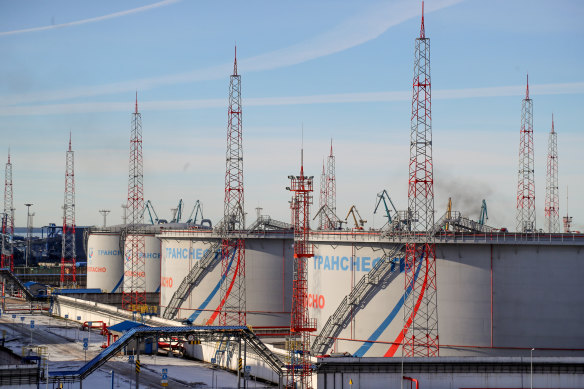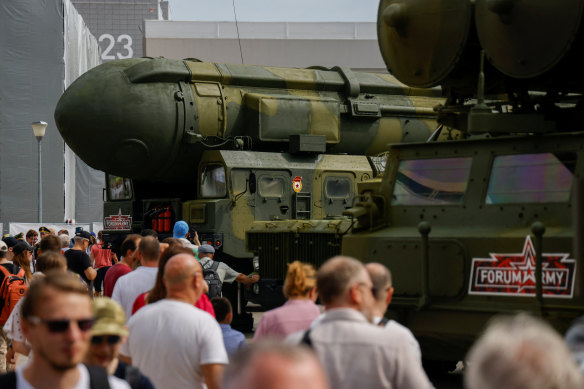
China, the world’s largest oil importer, now gets a third of its crude from its near neighbour, with Russia overtaking Saudi Arabia last year as China’s biggest supplier. Russia has, in return, bought ever more Chinese cars and smartphones as European and US brands have been told to withdraw. The value of good shipments from China to Russia has rocketed by two-thirds since the West imposed sanctions on Moscow.
This column often highlights the threat that geopolitical dangers could derail the global economy in a way that would disproportionately impact the West.

Russia overtook Saudi Arabia last year to become China’s biggest oil supplier.Credit: Getty Images
Escalating hostilities between Israel and Palestine could yet see Iran block the Strait of Hormuz, the gateway to the Gulf through which tankers carry 25 million barrels of oil a day to global markets – a quarter of global supply. Blocking that energy pinch-point would mean oil prices and inflation balloon, destroying plans to reboot Western economic confidence by lowering interest rates.
Another big risk is our growing dependence on rare earth minerals as we move to net zero emissions. This is vital not only in the manufacture of electric vehicle batteries, wind turbine hubs and solar panels but also consumer electronics. China boasts more than a third of known reserves of these crucial 17 elements – 10 times more than Australia and 20 times than the United States.
Having invested heavily, the People’s Republic also now controls no less than 70 per cent of current rare earth production worldwide and a staggering 85 per cent of total global capacity to process rare earth into usable form.
And China’s intensifying interest in Taiwan is also about more than misplaced nationalism, given that Taiwan produces more than half of all semiconductors used worldwide – a $US600 billion global market, expected to triple over the next five years given the importance of chips in AI and other technologies. Semiconductors will soon rival energy as the world’s key commodity input for growth.
The deepening Sino-Russian relationship, the heart of an emerging and commercially powerful anti-Western alliance, is among the most important developments of our time.
But the strengthening Russia-China relationship is also right up there when it comes to the geopolitical threats we face.
Russia is importing not just cars and machinery from China, but also critical military inputs needed to keep its war effort going, including components from Western Europe sent via China.
Moscow is also now sharing advanced military and aerospace technology with Beijing, helping China with air defence systems and submarines. All of this has huge geopolitical implications.
The widespread breaking of sanctions is also undermining Western hegemony. Russia is re-exporting oil via India, while conducting untold financial transactions via UAE – both supposed Western allies. Turkey and Kazakhstan are also getting closer to China, both making hay as hubs for Russia’s sanction-busting parallel imports – goods shipped without permission through third countries.

Russia is importing not just cars and machinery from China, but also critical military inputs needed to keep its war effort going, including components from Western Europe sent via China.Credit: Reuters
A recent report by the European Bank for Reconstruction and Development revealed a huge shift in trade patterns from Western Europe to former Soviet republics – with European Union exports to the Kyrgyz Republic up 172 per cent last year, and similar patterns seen in Georgia and Armenia, as well as Kazakhstan. It is difficult not to see this official data as at least circumstantial evidence that the EU is busting its own Russian sanctions.
And then there’s the huge rise in the use of the Chinese currency, rather than the dollar, in Sino-Russian trade. In 2016, just a tenth of Chinese exports to Russia were in renminbi. Now it’s two thirds, says the European Bank for Reconstruction and Development, with the RMB increasing its share in Russia’s overall trade almost tenfold, from under 4 per cent in 2021 to 33 per cent now.
Loading
When a major energy exporter and the world’s biggest manufacturer stop trading in dollars, that seriously undermines America’s “reserve currency status” and all the economic power that goes with it.
It’s easy to scoff at this China-Russia summit. Of course, Russia is the more needy partner, with China now buying more than half of Moscow’s exported oil and Russia’s biggest trading partner overall.
Trade with the US and EU, in contrast, is much more valuable to China, outstripping trade with Russia more than two-fold and three-fold respectively. Russia isn’t even in China’s top 10 trading partners overall.
Yet, the deepening Sino-Russian relationship, the heart of an emerging and commercially powerful anti-Western alliance, is among the most important developments of our time.









 Add Category
Add Category